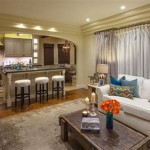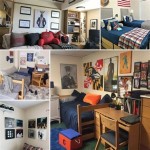Small Living Dining Room Decor: Maximizing Space and Style
Combining the living and dining areas is a common practice in smaller homes or apartments. This layout maximizes space and creates an open, flowing feel. However, decorating a combined living-dining room presents unique challenges. Successfully merging these two distinct functional spaces requires careful planning and execution to achieve both a stylish and practical space.
Defining Zones
One of the key principles in decorating a small living-dining room is establishing clear zones. While the spaces are combined, visually separating them helps maintain functionality and avoids a cluttered, disorganized feel. This can be achieved through several design strategies. Using area rugs is a simple yet effective method. Placing a rug under the dining table anchors the dining area, while a separate rug in the living area defines the conversation space.
Furniture placement is crucial in zone definition. Strategically positioning the sofa can create a visual barrier between the two areas. A sofa table placed behind the sofa further enhances this separation and provides additional surface area for décor or lighting. Alternatively, open shelving units can act as subtle room dividers while offering storage solutions. This allows light to pass through, maintaining the open feel of the combined space.
Lighting plays a critical role in visually separating zones. Different lighting fixtures can define each area's purpose. A pendant light or chandelier centered above the dining table designates it as a separate space, while floor lamps or wall sconces in the living area create a cozy and inviting atmosphere.
Choosing the Right Furniture
Furniture selection in a small combined living-dining room is paramount. Opting for multi-functional furniture pieces maximizes space utilization. A storage ottoman can serve as extra seating in the living area and provide hidden storage. Similarly, a bench with storage underneath can be used at the dining table and provide a place to store table linens or other items.
Scale and proportion are crucial considerations. Oversized furniture can easily overwhelm a small space. Choosing appropriately sized furniture pieces is essential to maintain a balanced and comfortable environment. Slim-profile sofas and chairs, compact dining tables, and nesting tables offer flexibility and practicality without sacrificing style.
Consider furniture with legs. Elevating furniture off the floor creates a sense of spaciousness and allows light to flow underneath, making the room appear larger. Glass-topped tables are also a good choice, as they visually take up less space than solid tables.
Color and Decor
Color palettes play a significant role in the perceived size and atmosphere of a small combined living-dining room. Light and neutral colors are generally recommended for walls, as they reflect light and create an airy feel. This doesn't mean the space needs to be devoid of color. Introducing color through accent pieces, such as throw pillows, rugs, artwork, and decorative accessories, allows for personality and visual interest without making the space feel cramped.
Mirrors can be strategically used to enhance the sense of space. Placing a large mirror on a wall reflects light and visually expands the room. However, careful consideration should be given to what the mirror reflects. Reflecting a cluttered area will only amplify the feeling of disorganization.
Maintaining a cohesive design aesthetic throughout the combined space is important. This doesn't necessarily mean matching everything perfectly, but rather ensuring a harmonious flow between the living and dining areas. Choosing a consistent color palette and style for furniture and décor creates a unified and visually appealing space.
Vertical space should not be overlooked. Utilizing wall space for shelves, artwork, and vertical storage solutions draws the eye upwards, creating the illusion of height and maximizing storage potential. This is particularly useful in small spaces where floor space is limited.
Finally, minimizing clutter is essential. Keeping surfaces clear and organized contributes significantly to a spacious and inviting atmosphere. Incorporating sufficient storage solutions is key to managing clutter effectively in a combined living-dining room. Utilizing baskets, decorative boxes, and closed storage cabinets helps maintain a tidy and visually appealing space.

Living Room And Dining Decorating Ideas Design

Стулья стол Living Room Dining Combo Small Rooms Condo

30 Living Room Dining Combo Ideas 2025 One For All Rectangle Rectangular Rooms

Living Room And Dining Design Ideas Designcafe

Living Room Dining Combo Ideas With Tricks Doğtaş

Small Dining Room Ideas Space Rooms

Living Room Decorating Ideas How To Decorate A Small

Small Living Dining Room Combo Ideas Transformer Table

Living Room Dining Combo Ideas With Tricks Doğtaş

Tips For Designing A Small Living Room Dining Combo Creative Green
Related Posts







